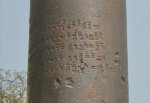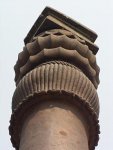- Joined
- Oct 25, 2011
- Messages
- 4,682
- Reaction score
- 1,905
- Location
- Lost at sea~
- Gender
- Female
- Political Leaning
- Libertarian - Right
Iron Pillar of Delhi has withstood the elements of nature "rust free" for 1602 years.(maybe longer)
The Incredible Rust-Resistant Iron Pillar of Delhi | Ancient Origins
30 MARCH, 2014 - 23:13 DHWTY
The Incredible Rust-Resistant Iron Pillar of Delhi

In the Qutb complex of Delhi stands one of the most curious metal objects in the world - the so called “Iron Pillar of Delhi”, which does not seem to rust, despite being over a thousand years old. The height of the pillar, from the top of its capital to the bottom of its base is 7.2 metres, of which 1.1 metre is underground. The base rests on a grid of iron bars soldered with lead into the upper layer of the dressed stone pavement. The pillar's lower diameter is 420 mm (17 in), and its upper diameter 306 mm (12.0 in). It is estimated to weigh more than six tons.”
While several inscriptions are found on the pillar, the oldest one is a six-line three stanza Sanskrit inscription in verse form. As the name Chandra is mentioned in the third verse, scholars have been able to date the making of the pillar to the reign of Chandragupta II Vikramaditya (375-415 A.D.), a Gupta king. Although it stands in Delhi today, how this pillar got there, and its original location is still a subject of scholarly discussion.
Pillar of Delhi - Detail showing the inscription of King Candragupta II

Photo source: Wikipedia
One theory suggests that from its original location, the pillar was moved and erected in the main temple at the fortress city of Lal Kot at Dhilli (modern Delhi) when it was developed by the Tomar king, Anangapala II, in A.D. 1050. This is based on an inscription found on the pillar itself. In A.D. 1191, Anangapala’s grandson, Prithiviraj Chauhan, was defeated by the slave army commander of Muhammad Ghori of Ghazni, Qutb-ud-din Aibak, and Lal Kot fell into the hands of the invading Muslim army. In order to commemorate his victory, Aibak erected a mosque, called the Quwwat-ul-Islam (Might of Islam), in Lal Kot. This mosque was built on the base of a temple, albeit not the one where the pillar was erected. Using archaeological evidence, and facts based on temple architecture, it has been proposed that the pillar was moved from the Tomar temple to its present location in front of the mosque in the Qutb Complex.
As mentioned earlier, one of the most interesting qualities of this pillar is its resistance to corrosion. Several theories have been put forward to explain this phenomenon. These theories fall into two main categories – material factors (favoured by Indian investigators), and environmental factors (favoured by foreign investigators).
One of these theories, the “Mixed Potential Theory” suggests that there is a co-relation between the processing, structure, and properties of the pillar’s iron. Based on scientific analysis, it has been shown that these three factors work together to form a protective passive layer of rust on the Iron Pillar of Delhi. As a result, the pillar does not undergo further corrosion, and appears to have not rusted over a thousand year.
Nevertheless, this ability to resist corrosion is not unique to the Iron Pillar of Delhi. Research has shown that other large ancient Indian objects have a similar property. These include the iron pillars at Dhar, Mandu, Mount Abu, Kodochadri Hill, and iron cannons. Hence, it may be said that the ancient Indian iron-workers were highly skilled at forging iron objects. In a report published in the journal Current Science, R. Balasubramaniam of the Indian Institute of Technology Kanpur, stated that the pillar is "a living testimony to the skill of metallurgists of ancient India"
Iron Pillar of Delhi

The quality of the iron used in the pillar is exceptionally pure and the detail at the top of the pillar demonstrates the skill of the craftsmen. Photo source: Wikipedia
One final thought regarding the Iron Pillar of Delhi: What man can make, man can also destroy. In 1997, a fence was erected around the pillar as a response to the damage caused by visitors. According to a popular belief, it is considered good luck if one could stand with one’s back to the pillar and make one’s hands meet behind it. Consequently, the protective passive layer of rust on the surface of the iron would have been inadvertently removed by visitors over time, leading to significant wear and visible discoloration on the lower portion of the pillar. It would be a great shame indeed if such monuments that reflect mankind’s ingenuity fall victim not to the ravages of time, but to the actions of man himself.
References
Balasubramaniam, R., 1998. The Corrosion Resistant Delhi Iron Pillar. [Online]
Available at: 404 - Error: 404
[Accessed 27 March 2014].
The Incredible Rust-Resistant Iron Pillar of Delhi | Ancient Origins
30 MARCH, 2014 - 23:13 DHWTY
The Incredible Rust-Resistant Iron Pillar of Delhi

In the Qutb complex of Delhi stands one of the most curious metal objects in the world - the so called “Iron Pillar of Delhi”, which does not seem to rust, despite being over a thousand years old. The height of the pillar, from the top of its capital to the bottom of its base is 7.2 metres, of which 1.1 metre is underground. The base rests on a grid of iron bars soldered with lead into the upper layer of the dressed stone pavement. The pillar's lower diameter is 420 mm (17 in), and its upper diameter 306 mm (12.0 in). It is estimated to weigh more than six tons.”
While several inscriptions are found on the pillar, the oldest one is a six-line three stanza Sanskrit inscription in verse form. As the name Chandra is mentioned in the third verse, scholars have been able to date the making of the pillar to the reign of Chandragupta II Vikramaditya (375-415 A.D.), a Gupta king. Although it stands in Delhi today, how this pillar got there, and its original location is still a subject of scholarly discussion.
Pillar of Delhi - Detail showing the inscription of King Candragupta II

Photo source: Wikipedia
One theory suggests that from its original location, the pillar was moved and erected in the main temple at the fortress city of Lal Kot at Dhilli (modern Delhi) when it was developed by the Tomar king, Anangapala II, in A.D. 1050. This is based on an inscription found on the pillar itself. In A.D. 1191, Anangapala’s grandson, Prithiviraj Chauhan, was defeated by the slave army commander of Muhammad Ghori of Ghazni, Qutb-ud-din Aibak, and Lal Kot fell into the hands of the invading Muslim army. In order to commemorate his victory, Aibak erected a mosque, called the Quwwat-ul-Islam (Might of Islam), in Lal Kot. This mosque was built on the base of a temple, albeit not the one where the pillar was erected. Using archaeological evidence, and facts based on temple architecture, it has been proposed that the pillar was moved from the Tomar temple to its present location in front of the mosque in the Qutb Complex.
As mentioned earlier, one of the most interesting qualities of this pillar is its resistance to corrosion. Several theories have been put forward to explain this phenomenon. These theories fall into two main categories – material factors (favoured by Indian investigators), and environmental factors (favoured by foreign investigators).
One of these theories, the “Mixed Potential Theory” suggests that there is a co-relation between the processing, structure, and properties of the pillar’s iron. Based on scientific analysis, it has been shown that these three factors work together to form a protective passive layer of rust on the Iron Pillar of Delhi. As a result, the pillar does not undergo further corrosion, and appears to have not rusted over a thousand year.
Nevertheless, this ability to resist corrosion is not unique to the Iron Pillar of Delhi. Research has shown that other large ancient Indian objects have a similar property. These include the iron pillars at Dhar, Mandu, Mount Abu, Kodochadri Hill, and iron cannons. Hence, it may be said that the ancient Indian iron-workers were highly skilled at forging iron objects. In a report published in the journal Current Science, R. Balasubramaniam of the Indian Institute of Technology Kanpur, stated that the pillar is "a living testimony to the skill of metallurgists of ancient India"
Iron Pillar of Delhi

The quality of the iron used in the pillar is exceptionally pure and the detail at the top of the pillar demonstrates the skill of the craftsmen. Photo source: Wikipedia
One final thought regarding the Iron Pillar of Delhi: What man can make, man can also destroy. In 1997, a fence was erected around the pillar as a response to the damage caused by visitors. According to a popular belief, it is considered good luck if one could stand with one’s back to the pillar and make one’s hands meet behind it. Consequently, the protective passive layer of rust on the surface of the iron would have been inadvertently removed by visitors over time, leading to significant wear and visible discoloration on the lower portion of the pillar. It would be a great shame indeed if such monuments that reflect mankind’s ingenuity fall victim not to the ravages of time, but to the actions of man himself.
References
Balasubramaniam, R., 1998. The Corrosion Resistant Delhi Iron Pillar. [Online]
Available at: 404 - Error: 404
[Accessed 27 March 2014].
